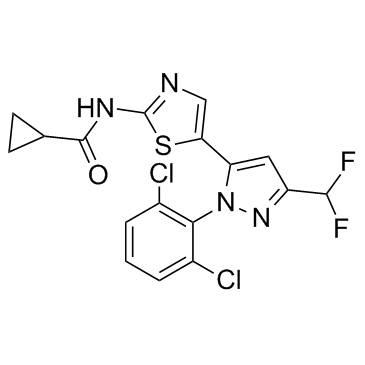
BMS-3
CAS No. 1338247-30-5
BMS-3( BMS-3 | BMS 3 | BMS3 )
Catalog No. M17955 CAS No. 1338247-30-5
BMS-3 is a potent LIMK inhibitor with IC50s of 5 nM and 6 nM for LIMK1 and LIMK2, respectively.
Purity : >98% (HPLC)
 COA
COA
 Datasheet
Datasheet
 HNMR
HNMR
 HPLC
HPLC
 MSDS
MSDS
 Handing Instructions
Handing Instructions
| Size | Price / USD | Stock | Quantity |
| 2MG | 43 | In Stock |


|
| 5MG | 68 | In Stock |


|
| 10MG | 107 | In Stock |


|
| 25MG | 219 | In Stock |


|
| 50MG | 365 | In Stock |


|
| 100MG | 531 | In Stock |


|
| 200MG | Get Quote | In Stock |


|
| 500MG | Get Quote | In Stock |


|
| 1G | Get Quote | In Stock |


|
Biological Information
-
Product NameBMS-3
-
NoteResearch use only, not for human use.
-
Brief DescriptionBMS-3 is a potent LIMK inhibitor with IC50s of 5 nM and 6 nM for LIMK1 and LIMK2, respectively.
-
DescriptionBMS-3 is a LIM kinase 1 (LIMK1) inhibitor. LIMK inhibition with 1 μM BMS-3 damaged MTOC protein localisation to spindle poles, undermined the formation and positioning of functional MTOC and thus disrupted spindle formation and chromosome alignment. These effects were phenocopied by microinjection of LIMK1 antibody into mouse oocytes. LIM kinase 1 (LIMK1) activity is essential for cell migration and cell cycle progression.
-
In VitroBMS-3 (Compound 2) causes a dose-dependent reduction in cell count and induces mitotic arrest by increases in total nuclear DNA intensity and histone H3 phosphorylation after 24 h treatment in A549 human lung cancer cells. BMS-3 inhibits A549 human lung cancer cells with EC50 value of 154 nM. BMS-3 is used to demonstrate the direct participation of LIMK1 in the phosphorylation of Cofilin. Inhibition of p-LIMK with 1-50 μM of BMS-3 results in a dose-dependent decrease of p-Cofilin after 10 min incubation in capacitating conditions. As a control, sperm are also incubated for 10 min under non-capacitating conditions which result in low levels of p-Cofilin. In the presence of 1 or 50 μM of BMS-3, actin polymerization levels are significantly lower compared to controls (DMSO). Mouse sperm are incubated under capacitating conditions for 90 min in the presence or absence of increasing concentrations of p-LIMK inhibitor BMS-3 (0, 1, 10 and 50 μM). The increasing concentrations of BMS-3 result in a strong decrease on the percentage of sperm that undergoes acrosomal exocytosis after stimulation with 20 μM of Progesterone.
-
In Vivo——
-
SynonymsBMS-3 | BMS 3 | BMS3
-
PathwayOthers
-
TargetOther Targets
-
RecptorLIMK1|LIMK2
-
Research AreaCancer
-
Indication——
Chemical Information
-
CAS Number1338247-30-5
-
Formula Weight429.27
-
Molecular FormulaC17H12Cl2F2N4OS
-
Purity>98% (HPLC)
-
SolubilityDMSO : ≥ 30 mg/mL6; 9.89 mM
-
SMILESO=C(Nc1ncc(s1)c2cc(nn2c3c(Cl)cccc3Cl)C(F)F)C4CC4
-
Chemical NameN-[5-[2-(2,6-Dichlorophenyl)-5-(difluoromethyl)pyrazol-3-yl]-1,3-thiazol-2-yl]cyclopropanecarboxamide
Shipping & Storage Information
-
Storage(-20℃)
-
ShippingWith Ice Pack
-
Stability≥ 2 years
Reference
1.Ross-Macdonald P, et al. Identification of a nonkinase target mediating cytotoxicity of novel kinase inhibitors. Mol Cancer Ther. 2008 Nov;7(11):3490-8.
molnova catalog



related products
-
TOPS
TOPS is a Trinder's reagent and is widely used in diagnostic tests and biochemical tests.
-
Peonidin chloride
Peonidin chloride has antioxidant activity. Peonidin has show potent inhibitory and apoptotic effects on cancer cells in vitro, notably metastatic human breast cancer cells.
-
3,7,25-Trihydroxycuc...
3,7,25-Trihydroxycucurbita-5,23-dien-19-al is a natural product for research related to life sciences.



 Cart
Cart
 sales@molnova.com
sales@molnova.com


